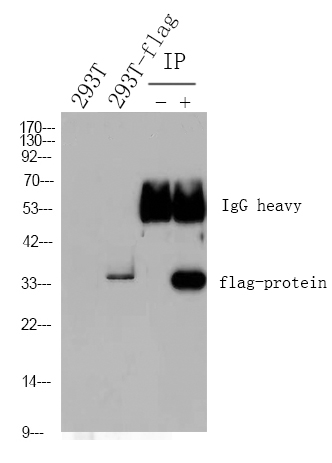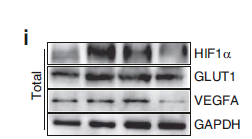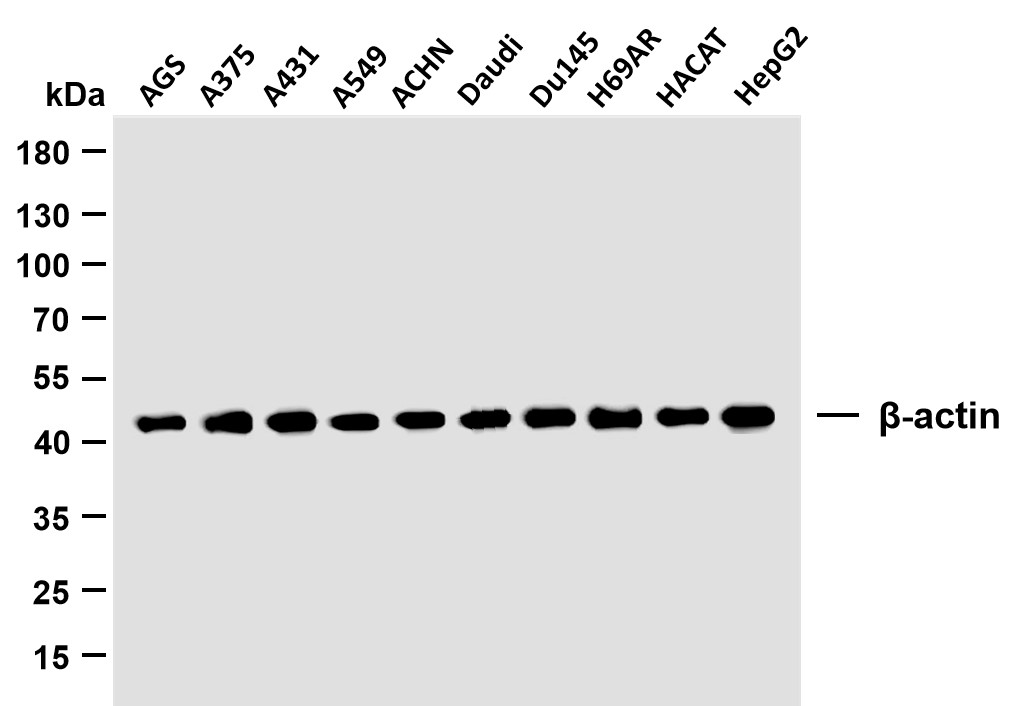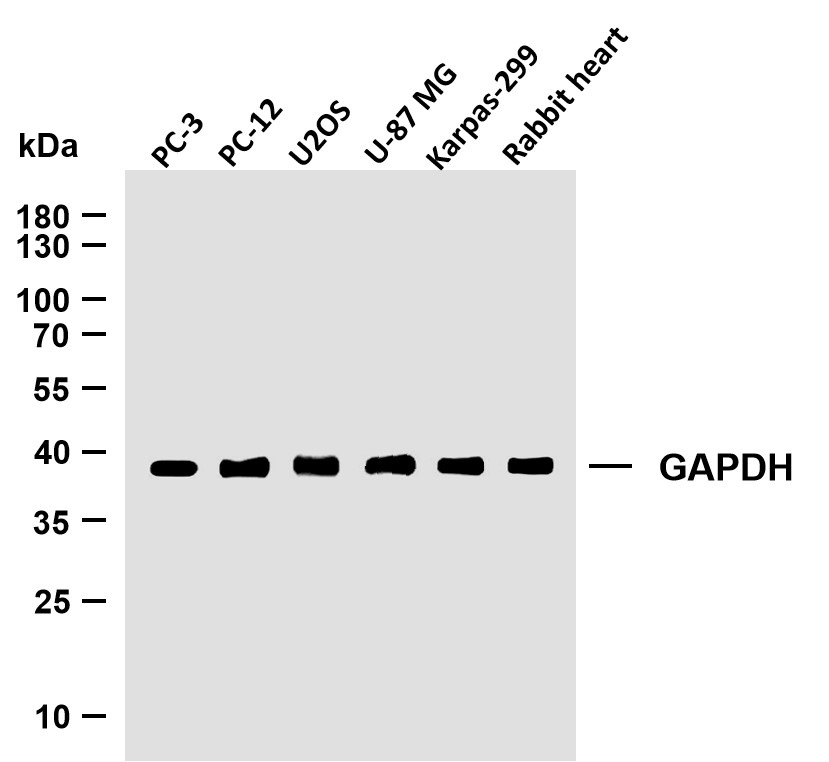
主要信息
Target
EGFR
Host Species
Rabbit
Reactivity
Human, Mouse, Rat,
Applications
WB, IHC, IF, IP, ELISA
MW
134kD (Calculated)
175kD (Observed)
Conjugate/Modification
Unmodified
货号: YM8344
规格
价格
货期
数量
200μL
¥3,780.00
现货
0
100μL
¥2,300.00
现货
0
40μL
¥960.00
现货
0
加入购物车


已收藏


收藏
详细信息
推荐稀释比
IHC 1:200-1:1000; WB 1:2000-1:10000; IF 1:200-1:1000; ELISA 1:5000-1:20000; IP 1:50-1:200;
组成
PBS, 50% glycerol, 0.05% Proclin 300, 0.05%BSA
特异性
Endogenous
纯化工艺
Protein A
储存
-15°C to -25°C/1 year(Do not lower than -25°C)
理论分子量
134kD
实测条带
175kD
修饰
Unmodified
克隆性
Monoclonal
克隆号
PT0520R
同种型
IgG,Kappa
相关产品
抗原&靶点信息
特异性:
Endogenous
展开内容
基因名称:
EGFR ERBB ERBB1 HER1
展开内容
蛋白名称:
Epidermal growth factor receptor
展开内容
别名:
EGFR ;
ERBB ;
ERBB1 ;
HER1 ;
Epidermal growth factor receptor ;
Proto-oncogene c-ErbB-1 ;
Receptor tyrosine-protein kinase erbB-1
ERBB ;
ERBB1 ;
HER1 ;
Epidermal growth factor receptor ;
Proto-oncogene c-ErbB-1 ;
Receptor tyrosine-protein kinase erbB-1
展开内容
背景:
The protein encoded by this gene is a transmembrane glycoprotein that is a member of the protein kinase superfamily. This protein is a receptor for members of the epidermal growth factor family. EGFR is a cell surface protein that binds to epidermal growth factor. Binding of the protein to a ligand induces receptor dimerization and tyrosine autophosphorylation and leads to cell proliferation. Mutations in this gene are associated with lung cancer. [provided by RefSeq, Jun 2016],
展开内容
功能:
Catalytic activity:ATP + a [protein]-L-tyrosine = ADP + a [protein]-L-tyrosine phosphate.,Disease:Defects in EGFR are associated with lung cancer [MIM:211980].,Function:Isoform 2/truncated isoform may act as an antagonist.,Function:Receptor for EGF, but also for other members of the EGF family, as TGF-alpha, amphiregulin, betacellulin, heparin-binding EGF-like growth factor, GP30 and vaccinia virus growth factor. Is involved in the control of cell growth and differentiation. Phosphorylates MUC1 in breast cancer cells and increases the interaction of MUC1 with C-SRC and CTNNB1/beta-catenin.,miscellaneous:Binding of EGF to the receptor leads to dimerization, internalization of the EGF-receptor complex, induction of the tyrosine kinase activity, stimulation of cell DNA synthesis, and cell proliferation.,online information:EGFR entry,PTM:Monoubiquitinated and polyubiquitinated upon EGF stimulation; which does not affect tyrosine kinase activity or signaling capacity but may play a role in lysosomal targeting. Polyubiquitin linkage is mainly through 'Lys-63', but linkage through 'Lys-48', 'Lys-11' and 'Lys-29' also occur.,PTM:Phosphorylation of Ser-695 is partial and occurs only if Thr-693 is phosphorylated.,similarity:Belongs to the protein kinase superfamily. Tyr protein kinase family.,similarity:Belongs to the protein kinase superfamily. Tyr protein kinase family. EGF receptor subfamily.,similarity:Contains 1 protein kinase domain.,subunit:Binds RIPK1. CBL interacts with the autophosphorylated C-terminal tail of the EGF receptor. Part of a complex with ERBB2 and either PIK3C2A or PIK3C2B. The autophosphorylated form interacts with PIK3C2B, maybe indirectly. Interacts with PELP1. Binds MUC1.,tissue specificity:Ubiquitously expressed. Isoform 2 is also expressed in ovarian cancers.,
展开内容
细胞定位:
Cell membrane ; Single-pass type I membrane protein . Endoplasmic reticulum membrane ; Single-pass type I membrane protein. Golgi apparatus membrane; Single-pass type I membrane protein. Nucleus membrane; Single-pass type I membrane protein. Endosome . Endosome membrane. Nucleus . In response to EGF, translocated from the cell membrane to the nucleus via Golgi and ER (PubMed:20674546, PubMed:17909029). Endocytosed upon activation by ligand (PubMed:2790960, PubMed:17182860, PubMed:27153536, PubMed:17909029). Colocalized with GPER1 in the nucleus of estrogen agonist-induced cancer-associated fibroblasts (CAF) (PubMed:20551055). .; [Isoform 2]: Secreted.
展开内容
组织表达:
Ubiquitously expressed. Isoform 2 is also expressed in ovarian cancers.
展开内容
研究领域:
>>EGFR tyrosine kinase inhibitor resistance ;
>>Endocrine resistance ;
>>MAPK signaling pathway ;
>>ErbB signaling pathway ;
>>Ras signaling pathway ;
>>Rap1 signaling pathway ;
>>Calcium signaling pathway ;
>>HIF-1 signaling pathway ;
>>FoxO signaling pathway ;
>>Phospholipase D signaling pathway ;
>>Endocytosis ;
>>PI3K-Akt signaling pathway ;
>>Focal adhesion ;
>>Adherens junction ;
>>Gap junction ;
>>JAK-STAT signaling pathway ;
>>Regulation of actin cytoskeleton ;
>>GnRH signaling pathway ;
>>Estrogen signaling pathway ;
>>Oxytocin signaling pathway ;
>>Relaxin signaling pathway ;
>>Parathyroid hormone synthesis, secretion and action ;
>>Cushing syndrome ;
>>Epithelial cell signaling in Helicobacter pylori infection ;
>>Shigellosis ;
>>Hepatitis C ;
>>Human cytomegalovirus infection ;
>>Human papillomavirus infection ;
>>Coronavirus disease - COVID-19 ;
>>Pathways in cancer ;
>>Proteoglycans in cancer ;
>>MicroRNAs in cancer ;
>>Chemical carcinogenesis - receptor activation ;
>>Chemical carcinogenesis - reactive oxygen species ;
>>Colorectal cancer ;
>>Pancreatic cancer ;
>>Endometrial cancer ;
>>Glioma ;
>>Prostate cancer ;
>>Melanoma ;
>>Bladder cancer ;
>>Non-small cell lung cancer ;
>>Breast cancer ;
>>Hepatocellular carcinoma ;
>>Gastric cancer ;
>>Central carbon metabolism in cancer ;
>>Choline metabolism in cancer ;
>>PD-L1 expression and PD-1 checkpoint pathway in cancer
>>Endocrine resistance ;
>>MAPK signaling pathway ;
>>ErbB signaling pathway ;
>>Ras signaling pathway ;
>>Rap1 signaling pathway ;
>>Calcium signaling pathway ;
>>HIF-1 signaling pathway ;
>>FoxO signaling pathway ;
>>Phospholipase D signaling pathway ;
>>Endocytosis ;
>>PI3K-Akt signaling pathway ;
>>Focal adhesion ;
>>Adherens junction ;
>>Gap junction ;
>>JAK-STAT signaling pathway ;
>>Regulation of actin cytoskeleton ;
>>GnRH signaling pathway ;
>>Estrogen signaling pathway ;
>>Oxytocin signaling pathway ;
>>Relaxin signaling pathway ;
>>Parathyroid hormone synthesis, secretion and action ;
>>Cushing syndrome ;
>>Epithelial cell signaling in Helicobacter pylori infection ;
>>Shigellosis ;
>>Hepatitis C ;
>>Human cytomegalovirus infection ;
>>Human papillomavirus infection ;
>>Coronavirus disease - COVID-19 ;
>>Pathways in cancer ;
>>Proteoglycans in cancer ;
>>MicroRNAs in cancer ;
>>Chemical carcinogenesis - receptor activation ;
>>Chemical carcinogenesis - reactive oxygen species ;
>>Colorectal cancer ;
>>Pancreatic cancer ;
>>Endometrial cancer ;
>>Glioma ;
>>Prostate cancer ;
>>Melanoma ;
>>Bladder cancer ;
>>Non-small cell lung cancer ;
>>Breast cancer ;
>>Hepatocellular carcinoma ;
>>Gastric cancer ;
>>Central carbon metabolism in cancer ;
>>Choline metabolism in cancer ;
>>PD-L1 expression and PD-1 checkpoint pathway in cancer
展开内容
信号通路
Cellular Processes >> Cellular community - eukaryotes >> Focal adhesion
Cellular Processes >> Cellular community - eukaryotes >> Adherens junction
Cellular Processes >> Cellular community - eukaryotes >> Gap junction
Cellular Processes >> Cell motility >> Regulation of actin cytoskeleton
Organismal Systems >> Endocrine system >> GnRH signaling pathway
Organismal Systems >> Endocrine system >> Estrogen signaling pathway
Organismal Systems >> Endocrine system >> Oxytocin signaling pathway
Organismal Systems >> Endocrine system >> Relaxin signaling pathway
Human Diseases >> Cancer: overview >> Pathways in cancer
Human Diseases >> Cancer: overview >> MicroRNAs in cancer
Human Diseases >> Cancer: overview >> Central carbon metabolism in cancer
Human Diseases >> Cancer: overview >> PD-L1 expression and PD-1 checkpoint pathway in cancer
Human Diseases >> Cancer: specific types >> Colorectal cancer
Human Diseases >> Cancer: specific types >> Pancreatic cancer
Human Diseases >> Cancer: specific types >> Hepatocellular carcinoma
Human Diseases >> Cancer: specific types >> Gastric cancer
Human Diseases >> Cancer: specific types >> Glioma
Human Diseases >> Cancer: specific types >> Melanoma
Human Diseases >> Cancer: specific types >> Bladder cancer
Human Diseases >> Cancer: specific types >> Prostate cancer
Human Diseases >> Cancer: specific types >> Endometrial cancer
Human Diseases >> Cancer: specific types >> Breast cancer
Human Diseases >> Cancer: specific types >> Non-small cell lung cancer
Environmental Information Processing >> Signal transduction >> MAPK signaling pathway
Environmental Information Processing >> Signal transduction >> ErbB signaling pathway
Environmental Information Processing >> Signal transduction >> Ras signaling pathway
Environmental Information Processing >> Signal transduction >> Rap1 signaling pathway
Environmental Information Processing >> Signal transduction >> JAK-STAT signaling pathway
Environmental Information Processing >> Signal transduction >> HIF-1 signaling pathway
Environmental Information Processing >> Signal transduction >> FoxO signaling pathway
Environmental Information Processing >> Signal transduction >> Calcium signaling pathway
Environmental Information Processing >> Signal transduction >> Phospholipase D signaling pathway
Environmental Information Processing >> Signal transduction >> PI3K-Akt signaling pathway
文献引用({{totalcount}})
货号: YM8344
规格
价格
货期
数量
200μL
¥3,780.00
现货
0
100μL
¥2,300.00
现货
0
40μL
¥960.00
现货
0
加入购物车


已收藏


收藏
Recently Viewed Products
Clear allToggle night Mode
{{pinfoXq.title || ''}}
Catalog: {{pinfoXq.catalog || ''}}
Filter:
All
{{item.name}}
{{pinfo.title}}
-{{pinfo.catalog}}
主要信息
Target
{{pinfo.target}}
Reactivity
{{pinfo.react}}
Applications
{{pinfo.applicat}}
Conjugate/Modification
{{pinfo.coupling}}/{{pinfo.modific}}
MW (kDa)
{{pinfo.mwcalc}}
Host Species
{{pinfo.hostspec}}
Isotype
{{pinfo.isotype}}
产品 {{index}}/{{pcount}}
上一个产品
下一个产品
{{pvTitle}}
滚轮缩放图片
{{pvDescr}}

























